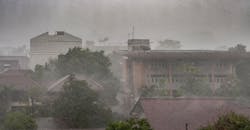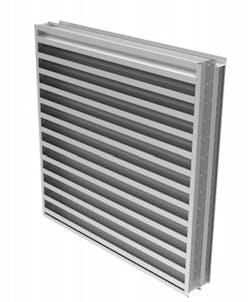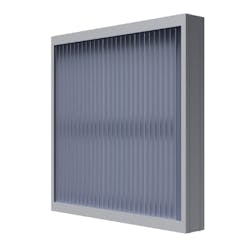The 2020 Atlantic hurricane season was the most active on record, generating 30 named storms – 12 of which made landfall. As climate change* continues escalating both the number and intensity of dangerous storms, protecting people and property in these vulnerable areas is now mission critical.
HVAC louvers, which are used to provide fresh airflow in a facility, can sometimes allow wind-driven rain into buildings during severe storm events, causing significant damage to the structure and equipment. There are two louver test standards developed to test for these high-velocity wind-driven rain events – TAS-100A and AMCA 550.
TAS-100A is the original Miami-Dade (Florida Building Code) test standard developed in the 1990s after Hurricane Andrew caused widespread destruction in that area. TAS-100A was the original test method that set the standard louvers needed to meet to be considered resistant to high wind and wind-driven rainfall. AMCA 550 is the latest testing standard for hurricane louvers. This article provides an overview of these standards and compares the testing efficacy of both.
Property-protecting louvers
Hurricane louvers are required to meet very stringent performance requirements, more so than regular louvers. Facilities along the eastern seaboard and Gulf Coast regions are required by International Building Code to install severe weather-resistant louvers in locations that require fresh-air intake or exhaust of carbon-dioxide-contaminated air. Hurricane louvers are specifically designed to resist the intake of excessive amounts of rainfall and debris carried by hurricane-force winds. Each hurricane louver is tested to specific standards and must be approved for use in a hurricane zone.
The TAS-100A standard uses a 48-inch-by-48-inch sample. Performance is tested against a rainfall rate of 8.8-inches per hour with wind gusts that are tested at a set number of minutes. The 35 mph, 70 mph and 90 mph tests are run for 15 minutes and the 110-mph test runs for five minutes.
After each test point, water that has passed through the louver is collected and weighed. To meet the more stringent TAS-100A standards, only 0.05% of the total water sprayed at it can pass through the louver, while at the first two set points of 35 mph and 70 mph, no water is allowed.
Testing standards for AMCA 550
The AMCA Standard 550 Test Method for High Velocity Wind Driven Rain Resistant Louvers has a similar test method as TAS-100A, but varies in water collection requirements, which make it more commonly specified.
AMCA 550 uses a 1-meter-by-1-meter sized sample to measure water damage impact. However, during the calibration of the test and measuring equipment, AMCA 550 requires collection of water at a different reference location. Similar to TAS-100A, the sample louver is mounted into a makeshift wall with a collection chamber inside the opening and an open top to allow a consistent air stream. The chamber’s walls are lined with plastic or similar smooth surface to funnel any penetrating water into a collection device for measurement.
During the test, water is injected into an air stream and directed at the sample louver. The test measurements are conducted at the same wind speeds as TAS-100A – which are 35 mph, 70 mph, 90 mph and 110 mph – as well as at the constant flow of 8.8 inches of rainfall per hour.
While both standards are widely accepted by authorities having jurisdiction (AHJ) in hurricane-prone regions, Miami-Dade has recognized AMCA 550 as an equivalent to their own TAS-100A test standard.
Although both are often perceived as interchangeable, three key differences are highlighted below:
AMCA 550
Water collection measured cumulatively at 35, 70, 90 and 110 mph. The louver passes if no more than 1% of water penetrates the louver.
Test size: 1 meter by 1 meter
More commonly specified
TAS-100A
Water collection measured at 35, 70, 90 and 110 mph. The louver passes if there is no water collected on the first two points and only 0.05% of water penetration at the end of the test.
Test size: 48 in. x 48-in.
More stringent test, so not commonly used, but is commonly specified in Miami-Dade/Florida region
Features of hurricane-compliant louvers
Most high-velocity wind-driven rain louvers have tight blade spacing with vertical orientations. The vertical blades use gravity to quickly drain the rain and reduce the risk of water puddles forming and blowing through the louver.
The industry does offer horizontal-bladed operable louvers, but they must be closed during a storm event to meet AMCA 550 requirements and must remain in the closed position until the storm subsides. Other products offer a combination of two louvers – typically a horizontal-bladed front louver and vertical-rear bladed louver.
Finally, there is a louver and damper combination. With this combination, the damper must be closed during a severe weather event to satisfy AMCA 550. However, both the operable louver and louver/damper combination are not permissible in essential facilities – such as hospitals, fire and police stations – which must remain open during a weather emergency.
Joe Rockhold is Louver Product Manager for Ruskin.
* The author's statement of the occurrence of and influence of climate change does not necessarily reflect the opinion of Contracting Business.


